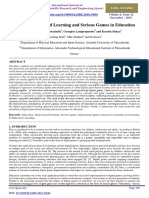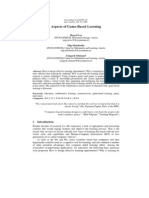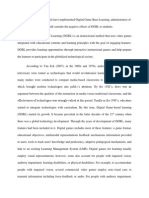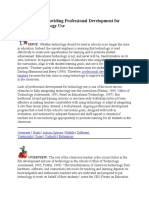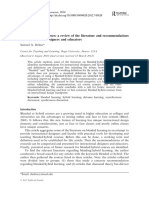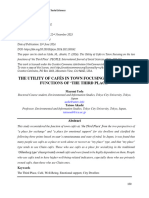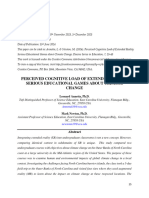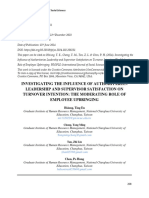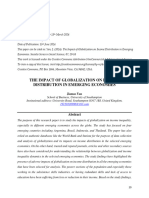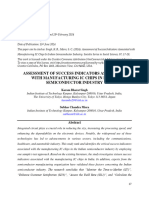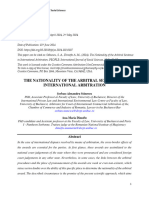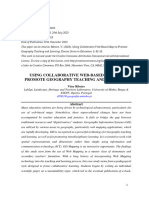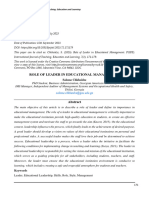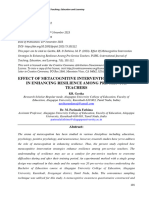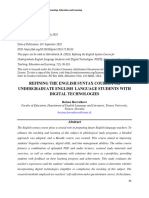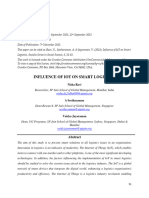Application of Gamification in Introduction To Programming - A Case Study
Uploaded by
Global Research and Development ServicesApplication of Gamification in Introduction To Programming - A Case Study
Uploaded by
Global Research and Development ServicesPEOPLE: International Journal of Social Sciences
ISSN 2454-5899
Jen & Said, 2019
Volume 4 Issue 3, pp. 845-864
Date of Publication: 4th January, 2018
DOI-https://dx.doi.org/10.20319/pijss.2019.43.845864
This paper can be cited as: Jen, L. S. & Said, S. H. M. (2019). Application of Gamification in
Introduction to Programming: A Case Study. PEOPLE: International Journal of Social Sciences, 4(3),
845-864.
This work is licensed under the Creative Commons Attribution-Non Commercial 4.0 International
License. To view a copy of this license, visit http://creativecommons.org/licenses/by-nc/4.0/ or send a
letter to Creative Commons, PO Box 1866, Mountain View, CA 94042, USA.
APPLICATION OF GAMIFICATION IN INTRODUCTION TO
PROGRAMMING: A CASE STUDY
Leong Siok Jen
Faculty of Informatics, Center for UOW Programmes, INTI International College Subang,
Selangor, Malaysia
siokjen.leong@newinti.edu.my
Siti Hawa Mohamed Said
Faculty of Informatics, Center for UOW Programmes, INTI International College Subang,
Selangor, Malaysia
sitihawa.msaid@newinti.edu.my
Abstract
Institution of higher educations has struggled to provide engaging method to learn
programming although effort has been made by educators but often with limited success. The
question is how best to teach introductory to programming for novices students is often not
addressed properly. This is because learning programming for college students especially for
new learners in programming present many challenges such as subject difficulty, lack of
motivation in doing exercises, passiveness in class and diversity of student abilities. Since
students often faced a lot of difficulties when learning introductory of programming,
gamification has the potential to provide a way to promote students’ motivation and
engagement while also providing feedback on the students’ level of competency of the learned
material. Gamification is the process of incorporating game elements into education in an
effort to increase student engagement.Thus, there appears to be a good fit between
introductory of programming and gamification. Taking these elements into consideration, this
paper seeks to apply the concept of gamification to semester 1 students taking Java
Programming as the first level of programming subject. Some best practices in gamification
Available Online at: http://grdspublishing.org/ 845
PEOPLE: International Journal of Social Sciences
ISSN 2454-5899
such as competitions, incorporating engaging games elements, scoring using rewards and
levels, badges, providing feedback, and providing homework to encourage informal learning
are going to be applied. Finally, several popular online applications such as Kahoot, Online
Crossword Puzzle and Online Quiz were also designed to see the impact on these
gamification tools towards learning of students. The game would be designed to have 3 levels
that increase in difficulties with competition as a core element to increase student’s
engagement. This paper would also seeks to design the user evaluation form that can be
used to determine the effects of applying gamification on the student’s engagement,
motivation level, and understanding of the topic in introductory programming subject.
Through the research findings it could provide a platform in formulating alternative ways
besides the traditional teaching method for educators in creating educational programming
games and applying it to teach novices in introductory programming subjects.
Keywords
Gamification, Student Engagement, Online Applications, Java Programming, Introductory to
Programming
1. Introduction
Programming is one of the key areas of computing course, through which a student is
required to acquire the competences. However, several problems have been reported in
literature related to learning programming. One of the reasons is high failure in programming
courses although decade of effort have been put to decrease these rate. Novice students face
challenges in learning programming due to lack of motivation, engagement and difficulties in
understanding the programming fundamentals especially for first year students. Weaker
students also find the computer programs and algorithm too abstract and complex entities that
involve concepts were hard to learn and teach (Olosson et. al., 2015). Furthermore, learning
programming with traditional methods such as lecture and lab session is often found to be
boring and ineffective (Nikula et. al., 2011). This sometimes causes students to cheat, feel
helpless and drop out from the course. (Robins et al, 2003, Adorjanet.al., 2013)
Today learners are a new profile who grew up in a digital age and have a different
learning style and higher requirement for teaching and learning. It was found that an average
student today spend 10,000 hours gaming by the time they reach 21 years old
(McGonigal,2015) which is a remarkable amount of time. Educators are faced with new
challenges on how to incorporate gaming, which is one of the technique that can promote
active learning to meet students who have a variety of learning style. The aim of the paper is
Available Online at: http://grdspublishing.org/ 846
PEOPLE: International Journal of Social Sciences
ISSN 2454-5899
to fill in the gap by identifying how best to incorporate gamification to make students
learning more engaging, motivated and increase student understanding. With this, it is hope
that it could provide a framework for educators on how to implement gamification to meet the
learning style of 21st century learners who are taking Java programming subject.
2. Literature Review
2.1 Gamification
This term refers to the use of game element in a non-game context to increase
engagement between human and computers (Deterding, 2012). The game elements are
characterised by the use of items such as points, badges and levels. According to (Deterding
et.al, 2011) the adoption of gamification did not see widespread before the 2nd half of 2010
although the term was first documented in 2008. It is also found that the early adopters of
gamification are mostly from the area of computing and IT schools. Gamification as an
academic topic is relatively young as compared to is boom in the area of business, marketing
corporate management and wellness initiative. According to Gartner Hype Cycle (Garner,
2013) it was indicated that gamification is at the peak of the Hyper Cycle and is expected to
reach the productivity plateau in five to ten years’ time.
The majority of the reviewed studies on gamification did yield positive results.
Findings studies performed in higher educationsettings showed that there are significant
improvements in subject understanding, diligence, and motivation for students learning
through gamification (Barata et al., 2013). It was found the use of gamification as a learning
tool is able to meet the gap as it reinforce not only knowledge but also develop soft skills such
as problem solving, collaboration and communication. It also able to provide motivation
power as gamification encourages engagement which is able to meet with just having the joy
of playing and possibilities of winning it. The embedding of gamification in programming
course could reduce dropout rate and enhance student participation and have a positive impact
on learning. (Azmi et.al, 2015). Muratet et al (2010) found that some platform may even help
recruit students in computer science. Given that gamification is known to promote
engagement and motivation, the idea to incorporate gamification principles to motivate the
students is appealing.
On the contrary, competition in gamification provide a powerful extrinsic motivator
but it has been criticized that it reduces intrinsic motivation and so reduce opportunities for
optimal learning. Research shown that students who lose in competition perceive themselves
as less competent and this dampen their intrinsic motivation.(Vallerand et.al., 1986)
Available Online at: http://grdspublishing.org/ 847
PEOPLE: International Journal of Social Sciences
ISSN 2454-5899
2.2 Related work
The use of gamification for learning is not entirely a new area. Malone in the 1980s
done research on how video games can be applied to education as a means to promote student
engagement and motivation. There is also generally an increase attempt to exploit the use of
gamification to facilitate learning of programming. Some institutions are experimenting with
the use of online resources for example Khan Academy which incorporate game elements
such as badges and points to make learning more fun and to reward progress. Although this is
happening, these resources occasionally struggle to keep learners engaged and it is unclear
how much learners actually learn or retain knowledge. (Dainel, 2012)
There are research attempts done to identify how gamification can be applied to
programming courses especially as a means to promote student engagement, motivation and
improve test score. For instance in a research done by Balraj, K. and Parul, K. (2012),
gamified approach was applied to teach the student programming concepts. It was found that
that gamification through using of badges encourages students to continue playing thus
encourage cognitive engagement.
A study by Ibáñez et al., (2014) to evaluate learning effectiveness and engagement
towards teaching C programming language to undergraduate Engineering students shows that
students continued working even after earning the maximum amount of grade points to collect
all the badges and wanted to still keep learning. The research findings found that that
gamification shows positive results on the engagement of students and moderate improvement
in learning outcome.
Vihavainen et al. (2014) present another approach whereby this paper reports about 60
pre-interventions and post-interventions and analyses their influence on students’ pass rates in
introductory to programming courses. Statistically, pass rates after these interventions
increased nearly by one third compared to traditional teaching.
3. Research Methodology
The syllabus included 15face-to-facetwo-hour lectures, 15 two-hour practical classes,
15 one-hour face-to-facetutorial, and 15 one-hour online tutorial. The lectures covered Java
programming concepts ranging from fundamental concepts to object-oriented programming.
Practical classes are done in computer laboratory where students were presented with a series
of programming tasks that they had to complete individually during the session, with the
tutors offering occasional help. Face-to-face and online tutorials are conducted as practice
sessions where students are given short questions to be discussed in groups. All course
Available Online at: http://grdspublishing.org/ 848
PEOPLE: International Journal of Social Sciences
ISSN 2454-5899
materials were uploaded to the institutional LMS on a weekly basis. The course evaluation
consisted of 7 lab tasks (14%), 3 online quizzes (6%), 3 programming assignments (30%),
and a final examination (50%).
The main purpose of this research study is to explore the impact of gamification to
students’ engagement and motivation in learning Java programming. It also seeks to gauge
students understanding on Java programming after implementing gamification. The below are
the 2 research questions that this research seeks to answer.
RO1:Does gamification promote students engagement and motivation in learning Java
programming for first year students?
RO2:Does students understanding on Java programming improved after
theimplementation of gamification?
In order to assess the impact of gamification to students’ engagement, motivation and
understanding a mixed research method which consist of both quantitative and qualitative
data is being employed. To collect qualitative data a focus group interview was conducted
with 10 randomly selected students who attended the Java Programming class in the first year
of the study. The student’sage ranged from 19 to 24 years old and are from different groups.
As for quantitive data is collected through on online survey of 9 questions to 22
students with four answer measured on a Likert scale of 1(Strongly Disagree) to 4 (Strongly
Agree).
In addition to that, an independent instructor observation of students’ behaviour during
the gamification activities was carried out. Specific dimension like interest and attitude was
observed to measure students’ motivation and engagement.
The table below summarizes the focus of the research methodology conducted for
each of the research objectives to obtain the research findings. More information of the online
survey questions were discussed in the Finding section of this research paper.
Table 1:Mapping of the Research Methodology against the Research Objectives
Research
Methodology Quantitative method Qualitative method
Research
Objectives
RO1 (engagement & Online survey Focus group interview.
motivation) (Q1,Q2,Q4,Q7) (Q1,Q3, Q4)
Observation.
Available Online at: http://grdspublishing.org/ 849
PEOPLE: International Journal of Social Sciences
ISSN 2454-5899
RO2 (understanding) Online survey Focus group interview.
(Q1, Q3, Q4)
Observation
(Q5,Q6)
4. Findings
An experiment was conducted on a group of students taking the subject on
Fundamental Programming. The students are year 1 students with very little previous
knowledge in programming. Normal class was conducted at the beginning with teaching
methods involving face-to-face lecture, tutorial, practical, and online learning.
The gamification activities took place in the middle of the semester. A detailed
explanation on the gamification activities was given to the students prior to the activities so
that they have a full understanding on what they were doing. In addition, instructor’s guidance
and feedback serve as scaffolding during and after the game based activity. This is in line
with the study of Raymond T. and Lesley T. (2015) thatclaims the importance of instructional
support, feedback and debriefing in game-based learning in a pilot study done in Singapore
Higher Education.
4.1 Gamification Elements Used
There is a variety of ways to implement gamification in classrooms. It normally
involves using several game elements to make the activities become gamelike. This research
chooses to use points, badges, and leaderboardsgamification elements.
4.1.1 Points
Points are awarded to students who have completed a particular task. There is no
maximum points to reach since in a typical game, players gets to accumulate as many points
as possible. Students who achieved the higher points will move up the ladder of achievement
in the leaderboard.
In this experiment, points are awarded after each level has been completed. The points
given are based on the correct answers provided by the students during an activity in a
particular level. An example of points collected for a level played is shown below. The table
was generated and shown on the subject’s Moodle page.
Available Online at: http://grdspublishing.org/ 850
PEOPLE: International Journal of Social Sciences
ISSN 2454-5899
Figure 1:Points collected at a single level of activity (Mohamed Said, 2018)
4.1.2 Badges
A badge can represent an achievement done by the students in exploring something
related to the topics covered in the syllabus taught. Badges are awarded based on completion
of an activity. For this experiment, a smiley badge is selected. Different number of badges are
awarded for different level of achievement. The students are able to view the total badge that
they have collected on a table shown on Moodle. The table is updated after each stage has
been completed.The badge collection table is shown below which was also shown on the
lecturer’s Moodle page for the subject.
Figure 2:Badge collections (Mohamed Said, 2018)
Available Online at: http://grdspublishing.org/ 851
PEOPLE: International Journal of Social Sciences
ISSN 2454-5899
4.1.3 Leaderboards
A leaderboard will be displayed throughout the duration of the experiment. It will
display the points accumulated after each level has been completed. A leaderboard is used to
serve as a motivator in this experiment. However, to avoid from demotivating the slow
progress students, only the top five points will be displayed on the leaderboard.An example of
the leaderboardextracted from the lecturer’s Moodle page that was used in this experiment is
shown below.
Figure 3:Leaderboard (Mohamed Said, 2018)
4.2 Software Used
Several software has been selected for this experiment. The following table
summarizes the software or web-based applications used.
Table 1:Summary of Software Selected
Software Description
Kahoot! A web based game where students race to be the first to
answer correctly the questions shown on the screen.
Students will use their own smart devices to select their
answer. Time limit is set for each question. Points will be
displayed at the end of the game.
PuzzleFast An online crossword puzzle where students race to be the
first to solve the puzzle. Clues are given that reflects the
subject content and students have to identify the correct
word for the clues.
Moodle Online Quiz An online quiz where more challenging questions are given
to the students to solve. Questions given are multiple choice
programming questions.
Available Online at: http://grdspublishing.org/ 852
PEOPLE: International Journal of Social Sciences
ISSN 2454-5899
4.3Course Content and Activities
The gamification activity for this research will be conducted in three weeks. Each
week the students are required to complete a race level for point collection and take part in a
badge collection activity. The following table shows the summary of all activities involved.
Table 2:Course Content and Activity Involved
Week Course Content Activity
1 Selection Structures Badge Collection: Stage 1 (using Moodle Lesson)
Points Collection Race: Level 1 (using Kahoot!)
2 Repetition Structures Badge Collection: Stage 2 (using PuzzleFast)
Points Collection Race: Level 2 (using Kahoot!)
3 Classes and Objects Badge Collection: Stage 3 (using PuzzleFast)
Points Collection Race: Level 3 (using Moodle Online
Quiz)
4.3.1 Points Collection Activity
The first activity is the race where every group was given certain time duration to
complete a task that will be given points when completed. These races are mainly to answer
questions related to programming constructs learned earlier.Therace involves three levels to
be completed, each has an increase in difficulties and challenges. Each level coversa single
topic and is different from the other levels.
In Level 1, Kahoot! is used where each group race to become the first group to select
the correct answer for each question shown. This race uses the standard Kahoot! quiz where
students are given 15 multiple choice questions related to selection structures. At the end of
the game, points are given to the students based on the fastest correct answer given during the
race. The top 5 winners are shown on the leaderboard on Moodle.At the end of the level, the
top five groups are displayed on a leaderboard shown in Moodle.
Available Online at: http://grdspublishing.org/ 853
PEOPLE: International Journal of Social Sciences
ISSN 2454-5899
Figure 4: Level 1 Kahoot! (Mohamed Said, 2018)
In Level 2, Kahoot! is still used but using a different kind of quiz called Jumble and
covers the repetition topic. In this quiz, the students are given multiple lines of codes that are
not in order and they are required to re-arrange the codes so that it can be executable
correctly. At the end of the game, points are given to the students based on the fastest correct
answer given during the race. The points are then added with the points collection at level 1.
The new top 5 winners are then shown on the leaderboard on Moodle.
Finally, in Level 3, the students first get to exchange their badges collected earlier
with hints for this level. Every two badges can be exchanged with 1 hint. Each hint is a
correct answer from one of the question in the last quiz. The students are only given the
answer but not the question it belongs to. The students then are asked to take part in an online
quiz on Moodle on the class and object topic. A total of 20 multiple choice questions are
given and they are given 60 minutes to answer the quiz. The points collected at this level is
added to the earlier points collected and the new top 5 winners are again shown on the
leaderboard.
Figure 5:Level 3 Moodle Online Quiz (Mohamed Said, 2018)
4.3.2 Badge Collection Activity
The second activity is a series of activities to allow the students to learn and gain more
knowledge in the topics taught by taking part in online lesson, or fun activity such as
crossword puzzle. After each of these activities, students are given badges depending on their
Available Online at: http://grdspublishing.org/ 854
PEOPLE: International Journal of Social Sciences
ISSN 2454-5899
effort. The badges collected can later be exchanged with hints that they can use in the last race
(the active quiz).There are also three stages in the badge collection activities. Each badge
collection activity must be done first before the race for each week.
In Stage 1, students are required to take part in an online Lesson set up on Moodle.
The Lesson component requires students to read several pages containing lesson on selection
structures. In between the pages there are short quizzes given with only two questions for
each quiz. This is repeated until the Lesson ends. At the end of the lesson, the students will be
given badges based on the results of the quizzes answered. If all answers are correct, two
badges will be given, if not all answers are correct but they get a minimum of five correct
answers 1 badge will be given, and if they get less than 5 correct answers no badge will be
given.
Figure 6: Stage 1 Moodle Lesson (Mohamed Said, 2018)
In stage 2, students are asked to take part in an online crossword puzzle called Puzzle
Fast based on the repetition structure topic. The completed puzzle must be uploaded to
Moodle to claim their badges. If they manage to upload the completed puzzle within 15
minutes, they will get 2 badges and if they upload the puzzle less than 30 minutes but more
than 15 minutes, they will get 1 badge. Stage 3 requires students to also do online crossword
puzzle but based on the class and object topic. The badges collected are shown on Moodle.
Available Online at: http://grdspublishing.org/ 855
PEOPLE: International Journal of Social Sciences
ISSN 2454-5899
Figure 7: Stage 2 Crossword Puzzle (Mohamed Said, 2018)
5. Results of Findings
5.1 Online Survey using Questionnaire
To gather quantitative feedback about the gamified experience, all students are asked
to complete 9 questions for an online survey at the end of the semester. Every question has 4
possible answer measured on a Likert scale of 1 (Strongly agree) to 4 (Strongly disagree).
Generally the survey shows positive results in terms of improvement in students’ motivation,
engagement and subject understanding.
Available Online at: http://grdspublishing.org/ 856
PEOPLE: International Journal of Social Sciences
ISSN 2454-5899
5.1.1 Engagement
The responses from question 1 and question 2 shows that nearly 80% of the students
find the class fun and engaging as it allows them to exchange ideas with others during the
gamification activities. The results are shown in the figures below.
Figure 8:Question 1 Responses
Figure 9: Question 2 Responses
5.1.2 Motivation
The data shows that about 77% of students are motivated by the use of points, badges
and leaderboard elements. However, 31.8% disagree that gamification increase the student’s
motivation to do self-study in order to do well in the gamification activities.
Figure 10: Question 4 Responses
Available Online at: http://grdspublishing.org/ 857
PEOPLE: International Journal of Social Sciences
ISSN 2454-5899
Figure 11: Question 7 Responses
5.1.3 Understanding
Around 78% of the students find that gamification helped improve their understanding
on the programming concept taught and it is a valuable use of instructor time. Finally, 63% of
students hope that gamification can be used in other subjects.
Figure 12: Question 5 Responses
Figure 13: Question 6 Responses
Available Online at: http://grdspublishing.org/ 858
PEOPLE: International Journal of Social Sciences
ISSN 2454-5899
Figure 14: Question 8 Responses
5.2 Focus Group Interview
The focus group interview was done by randomly selecting 10 students from various
groups. The interview questions are:
Q1. Do you think it is a good idea to use gamification to teach Java programming?
Why?
Q2.What need to be improved in the gamification activities?
Q3.Which particular gamificationactivity helps you most in your learning?
Q4.In one word, describe your gamification experience.
The overall reactions from the students’ focus group interview showed overall a
positive response. Below are several answers given by thestudents:
Sample answers for Q1:
“Yes it is a good idea as it makes the class more fun, interesting and challenging.
“Yes, I can get to understand the programming concept clearer after the answer is displayed
and explained by the lecturer”.
Sample answers for Q2:
“Please provide longer timing for brainstorming and a variety of questions types (such as
MCQ, writing short codes, T/F)”
“More examples should be given before the gamification activities.”
“Should allow students to practise how to use the Kahoot software before the gamification
activity since it is their first time using it.”
Available Online at: http://grdspublishing.org/ 859
PEOPLE: International Journal of Social Sciences
ISSN 2454-5899
Sample answers for Q3:
In conclusion, all students prefer the Kahoot activity as compared to the Crossword puzzle as
it is more interesting and have more coding questions. They find the Crossword Puzzle is
more appropriate to test theory concept which is better used for theory subjects.
Sample answers for Q4:
Positive words: Competitive, Challenging, Fun, Amazing, Tricky, Great
Negative words: Stress, Pressuring
The students who provided negative comments are those that got low marks for the
competition and they find the competitive nature of the game made them more stressful and
they cannot think properly because they get panicky easily in this kind of environment. They
believe that the winning teams will like it more than the losing teams.
5.3 Observation of Student Behaviour
Class observation was done for the Activity 2 and 3 of gamification. The following
behaviour was observed:
When the lecturer explained the instruction and the answer to the question they
actively listened to it. This is especially true when the last question was displayed
which was the most difficult question.
They brainstorm actively with their group members on the possible answer.
Show excitement especially when the results of the answer was answered.
Show they enjoyed the activity as some of them was clapping their hands, smiling
and laughing.
Some students asked the lecturer to explain further the answer they did not
understand. This show students are engaged and learning from this activity.
Student utilised decision-making or problem solving skills in responding to all the
activity designed.
Demonstrated body language that was relaxed with appropriate eye contact with
their group members and lecturer.
Class was more noisy that usual as a lot of discussion was being done.
However, there are some glitches faced during the gamification activities. Some of the
fonts projected in the screen were too small and students cannot see properly. Due to this
some students has to move in front and stand-up to see the words clearly. Students mention
Available Online at: http://grdspublishing.org/ 860
PEOPLE: International Journal of Social Sciences
ISSN 2454-5899
that it would be better if all the lights in the classroom were turn off as this would make the
screen image sharper. From this observation, it is clear that it is important to test run the
gamification in the actual site before the actual activity so that this issue would not happen.
7. Conclusion
To conclude this paper, learning programming is not easy for students but through
gamification it can lessen some of the learning burden of students. The initial study of
existing work show that there is a need to a new approach to learning Java programming
especially for novice students. It was found through many literature review gamification can
increase students motivation and engagement and improve learning if the game is properly
designed and implemented. However,the concept of gamification may look simple, a lot of
consideration needed to be look in to order to make student learning effective. This is because
there is currently no practical guidelines on how to include these elements in a coherent and
efficient manner.
The short experiment done for this research has shown that majority students feel
more motivated to learn programming after they have taken part in the gamification activities.
The activities have also made them become more engaging. This is reflected in the result of
the questionnaire and also seen during observation in which the students shown full focus on
the activity and excited to take part and answer the questions given. The gamification
activitieshave also helped them to gain better understanding in the topic covered. However,
there are a few negative comments from the students mainly regarding the too short time
given for them to answer the questions in the game or race conducted. This can be improved
in the future by looking into more suitable time duration given so that the students can have
enough time to discuss and therefore experience more effective learning when answering the
questions.
In terms of the software used, most of the students prefer Kahoot! because it is more
interesting and fun. This experiment has used limited number of software since the scope of
the experiment is small. Other software can be explored and used in the actual
implementation of gamification.
7.1 Research Limitation
We have to acknowledge some limitations in our research. The intervention already
showed some promising results but the length of the intervention was only for 3 weeks which
was considered short. It would be better if the experiment can be conducted over 2 semesters
and with more than one class. Due to the small number of participants, the results findings
Available Online at: http://grdspublishing.org/ 861
PEOPLE: International Journal of Social Sciences
ISSN 2454-5899
may not be so reliable. Hence, study with larger sample size of students must be carried out to
get more conclusive and reliable results
7.2 Scope of Future Research
The effect of gamification on different kinds of subject for example theory subjects
related to computing area could be as a future work. From this research a study on the
differences of implementation of gamification towards theory and programming subject could
be studied. A longitudinal study could also be performed to show the impact of gamified
courses towards students’ outcomes in the long run. It would be good to assess
whethergamification only has impact on the performance of the students for the individual
course itself orit has a larger impact on their overall performance towards obtaining their
degree.
Since students are not exposed to gamification learning activity before it would be
interesting to investigate the engagement and motivating factor when gamification is being
regularly conducted thus become less of a novelty for students.
The role of educator in motivating students to perform extra activities provided in
gamification platform remain a crucial factor to the success of gamification. (Tenorioet.al.,
2018). Hence it would be interesting if a study could be done in order to identify how best
educator can provide motivation for the learners when they are embarking on gamification for
their learning.
References
Adorjan, A, & Ines,F.(2013). MultipleIntelligence Approach and Competencies Applied To
ComputerScience 1. IEEE Frontiers in Education Conference.Oklahoma City, OK,
USAhttps://doi.org/10.1109/FIE.2013.6685014
Azmi, S, Iahad, N.A & Ahmad, .N. (2015). Gamification in online collaborative learning for
programming courses:A literature review. Journal of Engineering and Applied
Sciences, 10(23), 1-3
Balraj, K, Parul, K & Ahmad, .N. (2012). Gamification in Education—Learn Computer
Programming with Fun. International Journal of Computers and Distributed
Systemss, 2(1), 46-53.
Barata, G., Gama, S., Jorge, J., &Gonçalves, D. (2013). Improving participation and learning
with gamification. Proceedings of the First International Conference on Gameful
Design, Research, and Applications, Toronto, Ontario, Canada, October 02 - 04,
2013https://doi.org/10.1145/2583008.2583010
Available Online at: http://grdspublishing.org/ 862
PEOPLE: International Journal of Social Sciences
ISSN 2454-5899
Daniel, J, Parul, K & Ahmad, .N. (2012). Making sense of MOOCs: Musings in a maze of
myth, paradox and possibility. Journal of Interactive Media
Education, 3(1),. https://doi.org/10.5334/2012-18
Deterding, S., Dixon, D., Khaled, R., &Nacke, L. (2011). From game design elements to
gamefulness: Defining “gamification”, Proceedings of the 15th International
Academic MindTrek Conference: Envisioning Future Media Environments, Tampere,
Finland, September 28 - 30, 2011 https://doi.org/10.1145/2181037.2181040
Deterding, S. (2012). Gamification: designing for motivation. Interactions, 19(4), 14-
17.https://doi.org/10.1145/2212877.2212883
Gartner (2013). Gartner’s 2013 Hype Cycle for Emerging Technologies Maps Out Evolving
Relationship Between Humans and Machine. Retrieved 13, June 2018, from
http://www.gartner.com/newsroom/id/2575515
Ibáñez, M. .B, Di-serio, A & Delgado-kloos, C. (2014). Gamification for Engaging Computer
Science Students in Learning Activities: A Case Study. IEEE Transactions on
Learning Technologies, 7(3), 291-301.https://doi.org/10.1109/TLT.2014.2329293
Mcgonigal, J. (2015). Want To Succeed In Life? Play Video Games The Huffington
Post. Retrieved 10 July, 2018, from http://www.huffingtonpost.com/jane-
mcgonigal/videogames_b_823208.html
Mohamed said, S.H. (2018). Crossword Puzzle for Selection Statement. [Online]. [7 May
2018]. Available from:
https://www.puzzlefast.com/en/puzzles/2018041723081249/plain-puzzle
Mohamed said, S.H. (2018). Crossword Puzzle for Repetition Statement. [Online]. [30 April
2018]. Available from: 14 May 2018
Mohamed said, S.H. (2018). Kahoot! - My Kahoots. Retrieved 10 April 2018, from
https://create.kahoot.it/kahoots/my-kahoots
Mohamed said, S.H. (2018). Moodle Platform for UOW - CSIT111 . Retrieved 20 June
2018, from https://moodle.uowplatform.edu.au/login/index.php
Muratet, M., Torguet, P., Viallet, F., &Jessel, J. (2010). Experimental feedback on Prog&
Play, a serious game for programming practice. In 31st Annual Conference of the
European Association for Computer Graphics
Nikula, U, Gotel, O &Kasurinen, J. (2011). A Motivation Guided Holistic Rehabilitation of
the First Programming Course. ACM of Transaction Computer Education, 24(1), 24-
38.https://doi.org/10.1145/2048931.2048935
Available Online at: http://grdspublishing.org/ 863
PEOPLE: International Journal of Social Sciences
ISSN 2454-5899
Olsson, M, Mozelius, P & Collin, J. (2015). Visualisation and Gamification of e-Learning and
Programming Education. The Electronic Journal of e-Learning, 13(6), 441-454.
Raymond, T & Lesley, T. (2015). Game-Based Learning in Singapore Higher Education-A
Pilot Study. PEOPLE : International Journal of Social Sciences, 1(1), 577-578.
Robins, J &Rountree, N. (2003). Learning and Teaching Programming: A Review and
Discussion. Computer Science Education , 13(2), 137-
172.https://doi.org/10.1076/csed.13.2.137.14200
Tenorio et al.. (2018). Influence of Gamification on Khan Academy in Brazilian High
School. PUPIL:International Journal of Teaching, Education and Learning, 2(2), 51-
52https://doi.org/10.20319/pijtel.2018.22.5165
Vallerand et al.. (1986). Negative effects of competition on children's intrinsic
motivation. The Journal of Social Psychology, 126(5), 649-
656.https://doi.org/10.1080/00224545.1986.9713638
Vihavainen, A., Airaksinen, J., Watson, Ch. (2014). A systematic review of approaches for
teaching introductory programming and their influence on success. In: ICER
’14Proceedings of the tenth annual conference on International computing education
research, New York.https://doi.org/10.1145/2632320.2632349
Available Online at: http://grdspublishing.org/ 864
You might also like
- Gamification Approach To Enhance Students Engagement in Studying Language CourseNo ratings yetGamification Approach To Enhance Students Engagement in Studying Language Course6 pages
- Gamification and Game-Based Learning: Two Strategies For The 21st Century LearnerNo ratings yetGamification and Game-Based Learning: Two Strategies For The 21st Century Learner17 pages
- Digital Game-Based Learning and Serious Games in EducationNo ratings yetDigital Game-Based Learning and Serious Games in Education6 pages
- Student's Perception To Teacher's Role in Blended Learning According To Felder-Soloman Index of Learning StylesNo ratings yetStudent's Perception To Teacher's Role in Blended Learning According To Felder-Soloman Index of Learning Styles6 pages
- Gamification As An Instructional Strategy in Motivating and Improving The Academic Performance of Students in Practical Research 2100% (1)Gamification As An Instructional Strategy in Motivating and Improving The Academic Performance of Students in Practical Research 211 pages
- Game-Based Learning in Singapore Higher Education A Pilot StudyNo ratings yetGame-Based Learning in Singapore Higher Education A Pilot Study11 pages
- Motivational Teaching Strategies Among Teachers100% (1)Motivational Teaching Strategies Among Teachers103 pages
- Effective Technology Integration-Secondary EducationNo ratings yetEffective Technology Integration-Secondary Education17 pages
- Chapter 2 (Review of The Related Literature)No ratings yetChapter 2 (Review of The Related Literature)15 pages
- The Effectiveness of The Game-Based Learning SystemNo ratings yetThe Effectiveness of The Game-Based Learning System14 pages
- Impact of Instructional Materials in Teaching andNo ratings yetImpact of Instructional Materials in Teaching and8 pages
- An Effective Use of ICT For Education AnNo ratings yetAn Effective Use of ICT For Education An51 pages
- Why Do High School Students Lack Motivation in The ClassroomNo ratings yetWhy Do High School Students Lack Motivation in The Classroom14 pages
- Relationship of Students Internet Usage and Academic PerformanceNo ratings yetRelationship of Students Internet Usage and Academic Performance10 pages
- The Usage of Game-Based Learning in University Education. How To Motivate and Foster Creativity Among Adult Students Through Board GamesNo ratings yetThe Usage of Game-Based Learning in University Education. How To Motivate and Foster Creativity Among Adult Students Through Board Games19 pages
- Teacher Leaders' Experience in The Shared Leadership ModelNo ratings yetTeacher Leaders' Experience in The Shared Leadership Model4 pages
- Literature Review of Game-Based Learning in The ClassroomNo ratings yetLiterature Review of Game-Based Learning in The Classroom9 pages
- Tanza National Trade School: Senior High School - Academic TrackNo ratings yetTanza National Trade School: Senior High School - Academic Track35 pages
- Submitted By: Information, Communications and Technology StudentsNo ratings yetSubmitted By: Information, Communications and Technology Students23 pages
- Educational Digital Games: A Distraction or A Standard Learning Tool?No ratings yetEducational Digital Games: A Distraction or A Standard Learning Tool?4 pages
- NAME: - DATE: - GROUP NO: - YEAR & SECTION: - Module 5 Curriculum Design Models LESSON 1: Types of Curriculum DesignNo ratings yetNAME: - DATE: - GROUP NO: - YEAR & SECTION: - Module 5 Curriculum Design Models LESSON 1: Types of Curriculum Design7 pages
- Techy-Mazing Life - The Relationship of Technology To The Learning of Grade 11 Students in SMMS A.Y. 2019 - 2020 (3rd Title)No ratings yetTechy-Mazing Life - The Relationship of Technology To The Learning of Grade 11 Students in SMMS A.Y. 2019 - 2020 (3rd Title)11 pages
- Digital Literacy and Computer Attitude of Students - Basis for Intervention StrategiesNo ratings yetDigital Literacy and Computer Attitude of Students - Basis for Intervention Strategies21 pages
- Blended/hybrid Courses: A Review of The Literature and Recommendations For Instructional Designers and EducatorsNo ratings yetBlended/hybrid Courses: A Review of The Literature and Recommendations For Instructional Designers and Educators8 pages
- Blended Learnings Impact On Student Performance and Engagement INo ratings yetBlended Learnings Impact On Student Performance and Engagement I37 pages
- Sample-Research-Proposal-Defense-Template (2) - 083551No ratings yetSample-Research-Proposal-Defense-Template (2) - 08355125 pages
- Patterns of Technological Pedagogical and Content Knowledge in Preservice-Teachers' Literacy Lesson PlanningNo ratings yetPatterns of Technological Pedagogical and Content Knowledge in Preservice-Teachers' Literacy Lesson Planning14 pages
- Enhancing Competency of Teachers: A Teaching-And-Learning Enhancement GuideFrom EverandEnhancing Competency of Teachers: A Teaching-And-Learning Enhancement GuideNo ratings yet
- Paper 2 (2024.6.2) Students' Attitudes Towards The JELTAL-1No ratings yetPaper 2 (2024.6.2) Students' Attitudes Towards The JELTAL-18 pages
- 919-Article Text-5924-1-10-20240910 (1)No ratings yet919-Article Text-5924-1-10-20240910 (1)36 pages
- The Utility of Cafés in Town Focusing On The Two Functions of The Third Place'No ratings yetThe Utility of Cafés in Town Focusing On The Two Functions of The Third Place'13 pages
- Perceived Cognitive Load of Extended Reality Serious Educational Games About Climate ChangeNo ratings yetPerceived Cognitive Load of Extended Reality Serious Educational Games About Climate Change19 pages
- Investigating The Influence of Authoritarian Leadership and Supervisor Satisfaction On Turnover Intention: The Moderating Role of Employee UpbringingNo ratings yetInvestigating The Influence of Authoritarian Leadership and Supervisor Satisfaction On Turnover Intention: The Moderating Role of Employee Upbringing24 pages
- The Impact of Globalization On Income Distribution in Emerging EconomiesNo ratings yetThe Impact of Globalization On Income Distribution in Emerging Economies25 pages
- U.S. Perception and Policy On South China Sea Pre-Cold WarNo ratings yetU.S. Perception and Policy On South China Sea Pre-Cold War14 pages
- CSR Perception Effect Towards Student Consumer Purchasing Intention On Personal Care FMCG100% (1)CSR Perception Effect Towards Student Consumer Purchasing Intention On Personal Care FMCG32 pages
- Assessment of Success Indicators Associated With Manufacturing Ic Chips in Indian Semiconductor IndustryNo ratings yetAssessment of Success Indicators Associated With Manufacturing Ic Chips in Indian Semiconductor Industry12 pages
- Design of A Website To Support The Teaching-Learning Process of GeneticsNo ratings yetDesign of A Website To Support The Teaching-Learning Process of Genetics16 pages
- Content Slicing: Low-Code Management of Video, Graphics and More For Engaging ClassroomsNo ratings yetContent Slicing: Low-Code Management of Video, Graphics and More For Engaging Classrooms15 pages
- Methodology For Research-Informed Teaching and Learning in Electronics EngineeringNo ratings yetMethodology For Research-Informed Teaching and Learning in Electronics Engineering15 pages
- The Nationality of The Arbitral Sentence in International ArbitrationNo ratings yetThe Nationality of The Arbitral Sentence in International Arbitration7 pages
- Research On Aesthetic Cognition, Flow Experience and Technology Acceptance in Virtual Cultural ActivitiesNo ratings yetResearch On Aesthetic Cognition, Flow Experience and Technology Acceptance in Virtual Cultural Activities16 pages
- How Non-Curricular Arts Are Used To Strengthen The Social Status of EngineersNo ratings yetHow Non-Curricular Arts Are Used To Strengthen The Social Status of Engineers9 pages
- Analyzing The Relationship Between Industrial Policy and Entrepreneurial EcosystemNo ratings yetAnalyzing The Relationship Between Industrial Policy and Entrepreneurial Ecosystem13 pages
- Loss Analysis in Bread Production Process Using Material Flow Cost Accounting TechniqueNo ratings yetLoss Analysis in Bread Production Process Using Material Flow Cost Accounting Technique16 pages
- Examine The Effects of Goods and Services Tax (GST) and Its Compliance: Reference To Sierra LeoneNo ratings yetExamine The Effects of Goods and Services Tax (GST) and Its Compliance: Reference To Sierra Leone18 pages
- Interpretation and Justification of Rules For Managers in Business Organizations: A Professional Ethics PerspectiveNo ratings yetInterpretation and Justification of Rules For Managers in Business Organizations: A Professional Ethics Perspective10 pages
- Resolving A Realistic Middle Ground Towards The Sustainability Transition in The Global Political and Economic Landscape: A Comprehensive Review On Green CapitalismNo ratings yetResolving A Realistic Middle Ground Towards The Sustainability Transition in The Global Political and Economic Landscape: A Comprehensive Review On Green Capitalism29 pages
- Potential Factors Influence Failure of The Village-Owned Business: The Entity Village Autonomy of Indonesian Government's ProgramNo ratings yetPotential Factors Influence Failure of The Village-Owned Business: The Entity Village Autonomy of Indonesian Government's Program12 pages
- Using Collaborative Web-Based Maps To Promote Geography Teaching and LearningNo ratings yetUsing Collaborative Web-Based Maps To Promote Geography Teaching and Learning13 pages
- Challenges in The Implementation of Schoolbased Management of Developing Schools: Basis For A Compliance Framework100% (1)Challenges in The Implementation of Schoolbased Management of Developing Schools: Basis For A Compliance Framework14 pages
- The Ethical Perception On Utang Na Loob As Basis of Voter's Choice100% (2)The Ethical Perception On Utang Na Loob As Basis of Voter's Choice18 pages
- Perceived Self-Efficacy and Academic Performance of Stem Senior High School StudentsNo ratings yetPerceived Self-Efficacy and Academic Performance of Stem Senior High School Students13 pages
- Role of Leader in Educational ManagementNo ratings yetRole of Leader in Educational Management9 pages
- Effect of Metacognitive Intervention Strategies in Enhancing Resilience Among Pre-Service TeachersNo ratings yetEffect of Metacognitive Intervention Strategies in Enhancing Resilience Among Pre-Service Teachers12 pages
- Design and Implementation of An Arabic Braille Self-Learning WebsiteNo ratings yetDesign and Implementation of An Arabic Braille Self-Learning Website17 pages
- Bank-Specific and Macroeconomic Determinants of Banks Liquidity in Southeast AsiaNo ratings yetBank-Specific and Macroeconomic Determinants of Banks Liquidity in Southeast Asia18 pages
- Refining The English Syntax Course For Undergraduate English Language Students With Digital TechnologiesNo ratings yetRefining The English Syntax Course For Undergraduate English Language Students With Digital Technologies19 pages
- Regulation of Online Platforms, Intermediaries, and Markets in The European Union and ChinaNo ratings yetRegulation of Online Platforms, Intermediaries, and Markets in The European Union and China25 pages
- Use of Qualitative Research in Architectural Design and Evaluation of The Built EnvironmentNo ratings yetUse of Qualitative Research in Architectural Design and Evaluation of The Built Environment8 pages
- July 2011: Academic Calendar For B.Tech, BCA, BBA, MCA, MBA (2 Year Onwards)No ratings yetJuly 2011: Academic Calendar For B.Tech, BCA, BBA, MCA, MBA (2 Year Onwards)7 pages
- FI2 - S3 - TD3 - Cover Letter Sample Chemistry Qmul PDFNo ratings yetFI2 - S3 - TD3 - Cover Letter Sample Chemistry Qmul PDF2 pages
- Creating A Problem Solving Culture Basic - Best PDFNo ratings yetCreating A Problem Solving Culture Basic - Best PDF10 pages
- Research - Developing A Theoretical and Conceptual FrameworkNo ratings yetResearch - Developing A Theoretical and Conceptual Framework11 pages
- Magnússon. 2019. An Amalgam of Ideals-Images of Inclusion in The Salamanca StatementNo ratings yetMagnússon. 2019. An Amalgam of Ideals-Images of Inclusion in The Salamanca Statement15 pages
- Learnenglish Magazine Universities Support Pack 0No ratings yetLearnenglish Magazine Universities Support Pack 04 pages
- Action Research - Time Management (GROUP 4)67% (6)Action Research - Time Management (GROUP 4)31 pages
- The Challenges of Public Policy Formulation and Evaluation Through The Questions "What, Who, How, and When?No ratings yetThe Challenges of Public Policy Formulation and Evaluation Through The Questions "What, Who, How, and When?12 pages
- BE1013 - Decision Making, Risk and Value ManagementNo ratings yetBE1013 - Decision Making, Risk and Value Management4 pages
- How To Write An Academic CV: Careers ServiceNo ratings yetHow To Write An Academic CV: Careers Service2 pages
- Gamification Approach To Enhance Students Engagement in Studying Language CourseGamification Approach To Enhance Students Engagement in Studying Language Course
- Gamification and Game-Based Learning: Two Strategies For The 21st Century LearnerGamification and Game-Based Learning: Two Strategies For The 21st Century Learner
- Digital Game-Based Learning and Serious Games in EducationDigital Game-Based Learning and Serious Games in Education
- Student's Perception To Teacher's Role in Blended Learning According To Felder-Soloman Index of Learning StylesStudent's Perception To Teacher's Role in Blended Learning According To Felder-Soloman Index of Learning Styles
- Gamification As An Instructional Strategy in Motivating and Improving The Academic Performance of Students in Practical Research 2Gamification As An Instructional Strategy in Motivating and Improving The Academic Performance of Students in Practical Research 2
- Game-Based Learning in Singapore Higher Education A Pilot StudyGame-Based Learning in Singapore Higher Education A Pilot Study
- Effective Technology Integration-Secondary EducationEffective Technology Integration-Secondary Education
- The Effectiveness of The Game-Based Learning SystemThe Effectiveness of The Game-Based Learning System
- Why Do High School Students Lack Motivation in The ClassroomWhy Do High School Students Lack Motivation in The Classroom
- Relationship of Students Internet Usage and Academic PerformanceRelationship of Students Internet Usage and Academic Performance
- The Usage of Game-Based Learning in University Education. How To Motivate and Foster Creativity Among Adult Students Through Board GamesThe Usage of Game-Based Learning in University Education. How To Motivate and Foster Creativity Among Adult Students Through Board Games
- Teacher Leaders' Experience in The Shared Leadership ModelTeacher Leaders' Experience in The Shared Leadership Model
- Literature Review of Game-Based Learning in The ClassroomLiterature Review of Game-Based Learning in The Classroom
- Tanza National Trade School: Senior High School - Academic TrackTanza National Trade School: Senior High School - Academic Track
- Submitted By: Information, Communications and Technology StudentsSubmitted By: Information, Communications and Technology Students
- Educational Digital Games: A Distraction or A Standard Learning Tool?Educational Digital Games: A Distraction or A Standard Learning Tool?
- NAME: - DATE: - GROUP NO: - YEAR & SECTION: - Module 5 Curriculum Design Models LESSON 1: Types of Curriculum DesignNAME: - DATE: - GROUP NO: - YEAR & SECTION: - Module 5 Curriculum Design Models LESSON 1: Types of Curriculum Design
- Techy-Mazing Life - The Relationship of Technology To The Learning of Grade 11 Students in SMMS A.Y. 2019 - 2020 (3rd Title)Techy-Mazing Life - The Relationship of Technology To The Learning of Grade 11 Students in SMMS A.Y. 2019 - 2020 (3rd Title)
- Digital Literacy and Computer Attitude of Students - Basis for Intervention StrategiesDigital Literacy and Computer Attitude of Students - Basis for Intervention Strategies
- Blended/hybrid Courses: A Review of The Literature and Recommendations For Instructional Designers and EducatorsBlended/hybrid Courses: A Review of The Literature and Recommendations For Instructional Designers and Educators
- Blended Learnings Impact On Student Performance and Engagement IBlended Learnings Impact On Student Performance and Engagement I
- Sample-Research-Proposal-Defense-Template (2) - 083551Sample-Research-Proposal-Defense-Template (2) - 083551
- Patterns of Technological Pedagogical and Content Knowledge in Preservice-Teachers' Literacy Lesson PlanningPatterns of Technological Pedagogical and Content Knowledge in Preservice-Teachers' Literacy Lesson Planning
- Enhancing Competency of Teachers: A Teaching-And-Learning Enhancement GuideFrom EverandEnhancing Competency of Teachers: A Teaching-And-Learning Enhancement Guide
- Paper 2 (2024.6.2) Students' Attitudes Towards The JELTAL-1Paper 2 (2024.6.2) Students' Attitudes Towards The JELTAL-1
- The Utility of Cafés in Town Focusing On The Two Functions of The Third Place'The Utility of Cafés in Town Focusing On The Two Functions of The Third Place'
- Perceived Cognitive Load of Extended Reality Serious Educational Games About Climate ChangePerceived Cognitive Load of Extended Reality Serious Educational Games About Climate Change
- Investigating The Influence of Authoritarian Leadership and Supervisor Satisfaction On Turnover Intention: The Moderating Role of Employee UpbringingInvestigating The Influence of Authoritarian Leadership and Supervisor Satisfaction On Turnover Intention: The Moderating Role of Employee Upbringing
- The Impact of Globalization On Income Distribution in Emerging EconomiesThe Impact of Globalization On Income Distribution in Emerging Economies
- U.S. Perception and Policy On South China Sea Pre-Cold WarU.S. Perception and Policy On South China Sea Pre-Cold War
- CSR Perception Effect Towards Student Consumer Purchasing Intention On Personal Care FMCGCSR Perception Effect Towards Student Consumer Purchasing Intention On Personal Care FMCG
- Assessment of Success Indicators Associated With Manufacturing Ic Chips in Indian Semiconductor IndustryAssessment of Success Indicators Associated With Manufacturing Ic Chips in Indian Semiconductor Industry
- Design of A Website To Support The Teaching-Learning Process of GeneticsDesign of A Website To Support The Teaching-Learning Process of Genetics
- Content Slicing: Low-Code Management of Video, Graphics and More For Engaging ClassroomsContent Slicing: Low-Code Management of Video, Graphics and More For Engaging Classrooms
- Methodology For Research-Informed Teaching and Learning in Electronics EngineeringMethodology For Research-Informed Teaching and Learning in Electronics Engineering
- The Nationality of The Arbitral Sentence in International ArbitrationThe Nationality of The Arbitral Sentence in International Arbitration
- Research On Aesthetic Cognition, Flow Experience and Technology Acceptance in Virtual Cultural ActivitiesResearch On Aesthetic Cognition, Flow Experience and Technology Acceptance in Virtual Cultural Activities
- How Non-Curricular Arts Are Used To Strengthen The Social Status of EngineersHow Non-Curricular Arts Are Used To Strengthen The Social Status of Engineers
- Analyzing The Relationship Between Industrial Policy and Entrepreneurial EcosystemAnalyzing The Relationship Between Industrial Policy and Entrepreneurial Ecosystem
- Loss Analysis in Bread Production Process Using Material Flow Cost Accounting TechniqueLoss Analysis in Bread Production Process Using Material Flow Cost Accounting Technique
- Examine The Effects of Goods and Services Tax (GST) and Its Compliance: Reference To Sierra LeoneExamine The Effects of Goods and Services Tax (GST) and Its Compliance: Reference To Sierra Leone
- Interpretation and Justification of Rules For Managers in Business Organizations: A Professional Ethics PerspectiveInterpretation and Justification of Rules For Managers in Business Organizations: A Professional Ethics Perspective
- Resolving A Realistic Middle Ground Towards The Sustainability Transition in The Global Political and Economic Landscape: A Comprehensive Review On Green CapitalismResolving A Realistic Middle Ground Towards The Sustainability Transition in The Global Political and Economic Landscape: A Comprehensive Review On Green Capitalism
- Potential Factors Influence Failure of The Village-Owned Business: The Entity Village Autonomy of Indonesian Government's ProgramPotential Factors Influence Failure of The Village-Owned Business: The Entity Village Autonomy of Indonesian Government's Program
- Using Collaborative Web-Based Maps To Promote Geography Teaching and LearningUsing Collaborative Web-Based Maps To Promote Geography Teaching and Learning
- Challenges in The Implementation of Schoolbased Management of Developing Schools: Basis For A Compliance FrameworkChallenges in The Implementation of Schoolbased Management of Developing Schools: Basis For A Compliance Framework
- The Ethical Perception On Utang Na Loob As Basis of Voter's ChoiceThe Ethical Perception On Utang Na Loob As Basis of Voter's Choice
- Perceived Self-Efficacy and Academic Performance of Stem Senior High School StudentsPerceived Self-Efficacy and Academic Performance of Stem Senior High School Students
- Effect of Metacognitive Intervention Strategies in Enhancing Resilience Among Pre-Service TeachersEffect of Metacognitive Intervention Strategies in Enhancing Resilience Among Pre-Service Teachers
- Design and Implementation of An Arabic Braille Self-Learning WebsiteDesign and Implementation of An Arabic Braille Self-Learning Website
- Bank-Specific and Macroeconomic Determinants of Banks Liquidity in Southeast AsiaBank-Specific and Macroeconomic Determinants of Banks Liquidity in Southeast Asia
- Refining The English Syntax Course For Undergraduate English Language Students With Digital TechnologiesRefining The English Syntax Course For Undergraduate English Language Students With Digital Technologies
- Regulation of Online Platforms, Intermediaries, and Markets in The European Union and ChinaRegulation of Online Platforms, Intermediaries, and Markets in The European Union and China
- Use of Qualitative Research in Architectural Design and Evaluation of The Built EnvironmentUse of Qualitative Research in Architectural Design and Evaluation of The Built Environment
- July 2011: Academic Calendar For B.Tech, BCA, BBA, MCA, MBA (2 Year Onwards)July 2011: Academic Calendar For B.Tech, BCA, BBA, MCA, MBA (2 Year Onwards)
- FI2 - S3 - TD3 - Cover Letter Sample Chemistry Qmul PDFFI2 - S3 - TD3 - Cover Letter Sample Chemistry Qmul PDF
- Creating A Problem Solving Culture Basic - Best PDFCreating A Problem Solving Culture Basic - Best PDF
- Research - Developing A Theoretical and Conceptual FrameworkResearch - Developing A Theoretical and Conceptual Framework
- Magnússon. 2019. An Amalgam of Ideals-Images of Inclusion in The Salamanca StatementMagnússon. 2019. An Amalgam of Ideals-Images of Inclusion in The Salamanca Statement
- The Challenges of Public Policy Formulation and Evaluation Through The Questions "What, Who, How, and When?The Challenges of Public Policy Formulation and Evaluation Through The Questions "What, Who, How, and When?
- BE1013 - Decision Making, Risk and Value ManagementBE1013 - Decision Making, Risk and Value Management



